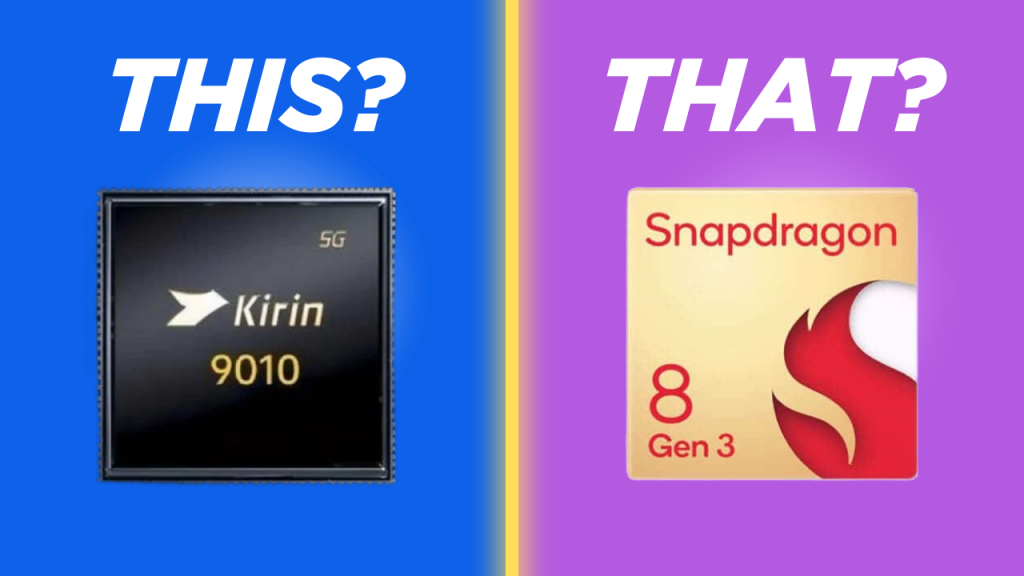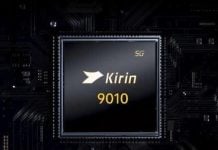A chipset is like the heart of a device, and therefore, it’s always a crucial decision to pick the best one. It is not just the performance; the chip also decides other parameters, such as the maximum camera resolution, RAM, and screen resolution the device supports.
Today, we’ll put the Huawei Kirin 9010, the company’s latest flagship chip, up against Qualcomm’s most powerful mobile chip – Snapdragon 8 Gen 3. Explore the comparison to pick the best flagship chip for a stellar performance.
| Feature | Kirin 9010 | Snapdragon 8 Gen 3 |
|---|---|---|
| Fabrication Process | 7nm | 4nm |
| CPU Cores | 1 x Taishan Prime Core @ 2.30 GHz 3 x Taishan Middle Core @ 2.18 GHz 4 x Cortex-A510 @ 1.55 GHz | 1 x Cortex-X4 @ 3.3 GHz 3 x Cortex-A720 @ 3.15 GHz 2 x Cortex-A720 @ 2.96 GHz 1 x Cortex-A520 @ 2.27 GHz |
| GPU | Maleoon 910 @ 750 MHz | Adreno 750 @ 770 MHz |
Kirin 9010 vs Snapdragon 8 Gen 3: Performance
Huawei hasn’t revealed the Kirin 9010 spec sheet, and it’s unlikely to do that in the near future. The new Kirin 9010 chip is nothing but the polished version of the Kirin 9000S found in the Huawei Mate 60 series.
For some reason, Huawei has underclocked the Kirin 9010’s prime core, which operates at 2.30 GHz (vs 2.62 GHz in Kirin 9000S). However, the three middle cores and the last four power-efficient cores get a slight clock bump.
The clock speeds of Kirin 9010 cores are nowhere near that of Snapdragon 8 Gen 3’s. Even the power-efficient Snapdragon 8 Gen 3 core operates at a higher clock speed than Kirin 9010’s middle cores.
The Kirin 9010 is fabricated using a 7nm technology, whereas the Snapdragon 8 Gen 3 uses a 4nm fabrication process, resulting in better power efficiency.
The Snapdragon chip also has a faster GPU. The core architecture of the Kirin 9010 is believed to be similar to the Kirin 9000S.
Kirin 9010 vs Snapdragon 8 Gen 3: Benchmark
Geekbench v6:
- Kirin 9010 (single-core): 1442
- Kirin 9010 (multi-core): 4471
- Snapdragon 8 Gen 3 (single-core): 2170
- Snapdragon 8 Gen 3 (multi-core): 6777
AnTuTu:
- Kirin 9010: 979511
- Snapdragon 8 Gen 3: 2114718
These numbers themselves tell the story. There’s a significant performance gap between the Snapdragon 8 Gen 3 and Kirin 9010 chipsets, with the Snapdragon one leading the race.
However, the Kirin 9010, despite having an underclocked prime core, is able to beat the Kirin 9000S in benchmarks by a small margin. But, the Snapdragon 8 Gen 3 is far ahead in the race.
Kirin 9010 vs Snapdragon 8 Gen 3: Games
The benchmarking numbers for the Huawei Kirin 9010 SoC are terrifying, but it does better than that in the real world. The Huawei P70 Ultra, powered by the same chip, was able to handle Genshin Impact fairly well.
The device resulted in an average frame rate of 60.2fps when running the same game at the highest settings with 60fps locked and the frame rate boosting feature turned off. The frame rate remained stable at around 60fps for the initial 10 minutes before dropping to 55.7fps over the next 15 minutes. The phone’s temperature reached a maximum of 46.8 degrees during the test.
Snapdragon 8 Gen 3, on the other hand, smoothly handles Genshin Impact and other resource-demanding titles while maintaining a 60fps stable frame rate. Secondly, the phone doesn’t get as warm as phones powered by the Kirin 9010 SoC.
Conclusion
While both Kirin 9010 and Snapdragon 8 Gen 3 are termed as flagship chipsets, there’s a lot of difference between them. In fact, the Snapdragon 8 Gen 3 beats the Huawei’s Kirin 9010 in every aspect. So, if you had to pick one of these two, it should be the Snapdragon 8 Gen 3.
Other Popular Chip Comparisons:
1. MediaTek Dimensity 7050 vs. Snapdragon 6 Gen 1
2. Snapdragon 8s Gen 3 vs Snapdragon 7+ Gen 2
3. Snapdragon 7+ Gen 3 vs. Snapdragon 8 Gen 2








